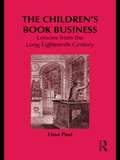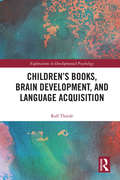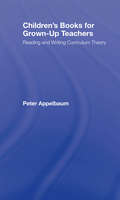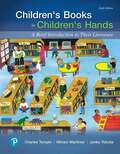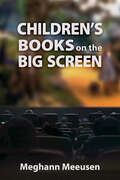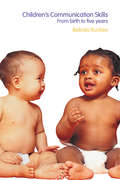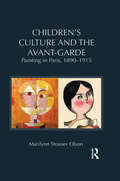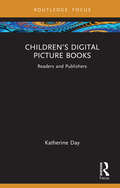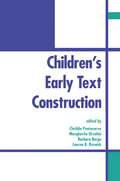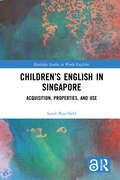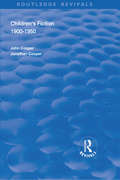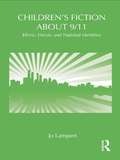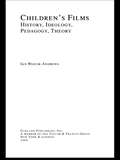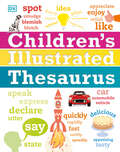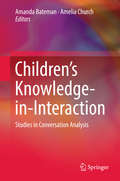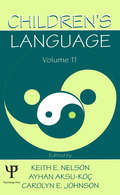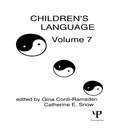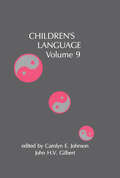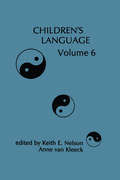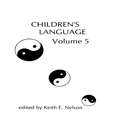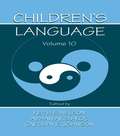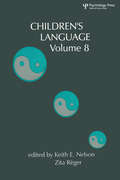- Table View
- List View
The Children's Book Business: Lessons from the Long Eighteenth Century (Children's Literature and Culture)
by Lissa PaulIn The Children’s Book Business, Lissa Paul constructs a new kind of book biography. By focusing on Eliza Fenwick’s1805 product-placement novel, Visits to the Juvenile Library, in the context of Marjorie Moon’s 1990 bibliography, Benjamin Tabart’s Juvenile Library, Paul explains how twenty-first century cultural sensibilities are informed by late eighteenth-century attitudes towards children, reading, knowledge, and publishing. The thinking, knowing children of the Enlightenment, she argues, are models for present day technologically-connected, socially-conscious children; the increasingly obsolete images of Romantic innocent and ignorant children are bracketed between the two periods. By drawing on recent scholarship in several fields including book history, cultural studies, and educational theory, The Children’s Book Business provides a detailed historical picture of the landscape of some of the trade practices of early publishers, and explains how they developed in concert with the progressive pedagogies of several female authors, including Eliza Fenwick, Mary Wollstonecraft, Anna Barbauld, Maria Edgeworth, and Ann and Jane Taylor. Paul’s revisionist reading of the history of children’s literature will be of interest to scholars working in eighteenth-century studies, book history, childhood studies, cultural studies, educational history, and children’s literature.
Children's books, brain development, and language acquisition (ISSN)
by Ralf ThiedeThis book correlates English-speaking children’s brain development and acquisition of language with the linguistic input that comes from children’s books. Drawing from the most current research on the developing brain, the author demonstrates how language acquisition is exclusively interactive, and highlights the benefit that accrues when that interaction includes the exploratory language play found in early childhood literature. Through discussions of specific domains of grammar, the relation of these domains to children’s literature through scaffolding, and the resultant linguistic and cognitive advantages for the child, this volume offers an innovative approach to early brain maturation.
Children's Books for Grown-Up Teachers: Reading and Writing Curriculum Theory (Studies in Curriculum Theory Series)
by Peter AppelbaumTeachers and prospective teachers read children's books, but that reading is often done as a "teacher" – that is, as planning for instruction – rather than as a "reader" engaged with the text. Children’s Books for Grown-Up Teachers models the kind of thinking about teaching and learning – the sort of curriculum theorizing – accomplished through teachers’ interactions with the everyday materials of teaching. It starts with children’s books, branches out into other youth culture texts, and subsequently to thinking about everyday life itself. Texts of curriculum theory describe infrastructures that support the crafts of inquiry and learning, and introduce a new vocabulary of poaching, weirding, dark matter, and jazz. At the heart of this book is a method of reading; Each reader pulls idiosyncratic concepts from children’s books and from everyday life. Weaving these concepts into a discourse of curriculum theory is what makes the difference between "going through the motions of teaching" and "designing educational experiences. This book was awarded the 2009 AERA Division B (Curriculum Studies) Outstanding Book Award.
Children's Books in Children's Hands: An Introduction to Their Literature
by Charles A. Temple Miriam A. Martinez Junko YokotaPre-service and in-service teachers alike benefit from the experience of renowned authors Charles Temple, Miriam Martinez, and Junko Yokota as they share a wealth of richly illustrated, practical ideas for sharing literature with children. The authors focus on creating an understanding of how literature works and how children respond to literature, they provide a wide range of good books to use with children, and they suggest ways to guide children into books and help them enjoy the experience. Dozens of new authors and books have been added to this new edition of Children's books in Children's Hands: An Introduction to Their Literature, 4e, making it interesting and current, and the continued emphasis on cultural diversity includes a new chapter on international books.
Children's Books in Children's Hands: A Brief Introduction to Their Literature
by Charles Temple Miriam Martinez Junko YokotaChildren’s Books in Children’s Hands: A Brief Introduction to Their Literature familiarizes current and future teachers with the best and most recent books for children. The renowned author team presents richly illustrated, practical ideas for sharing literature with children as a source of enjoyment and inspiration that will last them all their lives. This authoritative, captivating, and popular guide establishes a roadmap for understanding the world of children’s literature, including its writers, illustrators, editors, and critics, while also providing a strong emphasis on books from many cultural groups. <p><P>The 6th Edition now includes full color illustrations and art, newer title annotations, new teaching ideas, coverage of shifting changes in genres, and thorough coverage of multicultural and international books.
Children's Books on the Big Screen (Children's Literature Association Series)
by Meghann MeeusenIn Children’s Books on the Big Screen, Meghann Meeusen goes beyond the traditional adaptation approach of comparing and contrasting the similarities of film and book versions of a text. By tracing a pattern across films for young viewers, Meeusen proposes that a consistent trend can be found in movies adapted from children’s and young adult books: that representations of binaries such as male/female, self/other, and adult/child become more strongly contrasted and more diametrically opposed in the film versions. The book describes this as binary polarization, suggesting that starker opposition between concepts leads to shifts in the messages that texts send, particularly when it comes to representations of gender, race, and childhood. After introducing why critics need a new way of thinking about children’s adapted texts, Children’s Books on the Big Screen uses middle-grade fantasy adaptations to explore the reason for binary polarization and looks at the results of polarized binaries in adolescent films and movies adapted from picture books. Meeusen also digs into instances when multiple films are adapted from a single source such as The Wonderful Wizard of Oz and ends with pragmatic classroom application, suggesting teachers might utilize this theory to help students think critically about movies created by the Walt Disney corporation. Drawing from numerous popular contemporary examples, Children’s Books on the Big Screen posits a theory that can begin to explain what happens—and what is at stake—when children’s and young adult books are made into movies.
Children's Communication Skills: From Birth to Five Years
by Belinda BuckleyBased on a huge body of research in child language and communication development, Children's Communication Skills uses a clear format to set out the key stages of communication development in babies and young children. Its aim is to increase awareness in professionals working with children of what constitutes human communication and what communication skills to expect at any given stage. Illustrated throughout with real-life examples, this informative text addresses: normal development of verbal and non-verbal communication skills the importance of play in developing these skills developmental communication problems bilingualism, cognition and early literacy development working with parents of children with communication difficulties. Features designed to make the book an easy source of reference include chapter summaries, age-specific skills tables, sections on warning signs that further help may be needed, and a glossary of key terms. It will be of great use to a wide range of professionals in training or working in health, education and social care.
Children's Culture and the Avant-Garde: Painting in Paris, 1890-1915 (Children's Literature and Culture #86)
by Marilynn Strasser OlsonThis volume explores the mutual influences between children’s literature and the avant-garde. Olson places particular focus on fin-de-siècle Paris, where the Avant-garde was not unified in thought and there was room for modernism to overlap with children’s literature and culture in the Golden Age. The ideas explored by artists such as Florence Upton, Henri Rousseau, Sir William Nicholson, Paula Modersohn-Becker, and Marc Chagall had been disseminated widely in cultural productions for children; their work, in turn, influenced children’s culture. These artists turned to children’s culture as a "new way of seeing," allied to a contemporary interest in international artistic styles. Children’s culture also has strong ties to decadence and to the grotesque, the latter of which became a distinctively Modernist vision. This book visits the qualities of the era that were defined as uniquely childlike, the relation of childhood to high and low art, and the relation of children’s literature to fin-de-siècle artistic trends. Topics of interest include the use of non-European figures (the Golliwogg), approaches to religion and pedagogy, to oppression and motherhood, to Nature in a post-Darwinian world, and to vision in art and life. Olson’s unique focus covers new ground by concentrating not simply on children's literature, but on how childhood experiences and culture figure in art.
Children’s Digital Picture Books: Readers and Publishers
by Katherine DayDuring the COVID-19 pandemic lockdowns, children’s media use increased (Mesce et al. 2021) while a decrease in print-book reading was observed (Nolan et al. 2022). An increase in tablet use suggests that when children were reading, it was mostly online in the form of ePub3 pdf files for illustrated works and prescribed school texts, while smartphone use was linked to apps and games. (Susilowati et al. 2021) For many years now, children’s publishers have experimented with digital picture-book formats but have regarded the genre as not suitable for digitisation.This book documents the findings of a one-year research project engaging the children’s publishing sector for feedback on reading trends and digital publishing in picture-book genres. The research assesses the plight of picture books in the current climate and considers how picture-book publishers cater to diverse readerships and new reading platforms post Covid-19 lockdowns and into the digital age.Written by an academic and editor with over 15 years industry experience, this book offers a nuanced response to children’s picture book publishing and reception for librarians, teachers, publishers and international scholars in the fields of publishing studies, library studies, early childhood studies, early education and childhood psychology.
Children's Early Text Construction
by Clotilde Pontecorvo Margherita Orsolini Barbara Burge Lauren B. ResnickFor decades, research on children's literacy has been dominated by questions of how children learn to read. Especially among Anglophone scholars, cognitive and psycholinguistic research on reading has been the only approach to studying written language education. Echoing this, debates on methods of teaching children to read have long dominated the educational scene. This book presents an alternative view. In recent years, writing has emerged as a central aspect of becoming literate. Research in cognitive psychology has shown that writing is a highly complex activity involving a degree of planning unknown in everyday conversational uses of language. At the same time, developmental studies have revealed that when young children are asked to "write," they show a surprisingly sophisticated understanding of the representational constraints of alphabetic writing systems. They show this understanding long before they can read conventional writing on their own. The rich structure of meanings involved in the word text provided the glue that brought together a group of scholars from several disciplines in an international workshop held in Rome. Reflecting the state of the field at the time, the majority of the workshop participants were scholars working in languages other than English, especially the romance languages. Their work mirrors a linguistic and psychological research tradition that Anglophone scholars knew little of until recently. This volume provides English-language readers with updated versions of the papers presented at the meeting. The topics discussed at the workshop are represented in the chapters as follows: * the relationship between acquisition of language and familiarity with written texts; * the reciprocal "permeability" between spoken and written language; * the initial phases of text construction by children; and * the educational conditions that facilitate written language acquisition and writing practice.
Children’s English in Singapore: Acquisition, Properties, and Use (Routledge Studies in World Englishes)
by Sarah BuschfeldCombining the World Englishes framework with First Language Acquisition methodology, this book investigates children’s acquisition of L1 English in the context of multilingual Singapore, one of the traditional Kachruvian Outer Circle or ESL countries. The book investigates language choice, use, and dominance in Singaporean families, identifies common linguistic characteristics of L1 Singapore English, as well as the acquisitional route that Singaporean children take. It discusses characteristics at the different levels of language organization, i.e., phonological, morphosyntactic, lexical, and pragmatic features, drawing on a variety of systematically elicited data and Praat-based acoustic analyses. Comparing the results to similar data obtained from children living in England (both mono- and bi-/multilingual), the book also sheds light on how the acquisitional steps taken by Singaporean children differ from or are similar to traditional native speakers of English and children from immigrant families in England.
Children's Fantasy Literature
by Michael Levy Farah Mendlesohn Levy MichaelFantasy has been an important and much-loved part of children's literature for hundreds of years, yet relatively little has been written about it. Children's Fantasy Literature traces the development of the tradition of the children's fantastic - fictions specifically written for children and fictions appropriated by them - from the sixteenth to the twenty-first century, examining the work of Lewis Carroll, L. Frank Baum, C. S. Lewis, Roald Dahl, J. K. Rowling and others from across the English-speaking world. The volume considers changing views on both the nature of the child and on the appropriateness of fantasy for the child reader, the role of children's fantasy literature in helping to develop the imagination, and its complex interactions with issues of class, politics and gender. The text analyses hundreds of works of fiction, placing each in its appropriate context within the tradition of fantasy literature.
Children's Fiction 1900–1950 (Routledge Revivals)
by John CooperFirst published in 1998, this volume explores how the genre of school stories had become firmly established by the turn of the twentieth century, having been built on the foundations laid by writers such as Thomas Hughes and F.W. Farrar. Stories for girls were also taking on a more exciting complexion, inspired by the ‘Katy’ books of Susan Coolidge. The first five decades of the twentieth century saw further developments in children’s fiction. In this comprehensive volume, John and Jonathan Cooper examine each decade in turn, with alphabetically arranged entries on popular children’s writers that published works in English during that period. 206 different authors are covered, many from the United States and Canada. Each entry provides information on the author’s pseudonyms, date of birth, nationality, titles of works, place and date of publication and the publisher’s name. The artist responsible for a book’s illustrations is also identified where possible. With over 200 illustrations of cover designs and dustwrappers, many of which are now rare and have never before been published, this book will delight collectors, dealers, scholars, librarians, parents and all those who simply enjoy reading children’s fiction.
Children's Fiction about 9/11: Ethnic, National and Heroic Identities (Children's Literature and Culture)
by Jo LampertIn this pioneering and timely book, Lampert examines the ways in which cultural identities are constructed within young adult and children’s literature about the attacks of September 11, 2001. Looking at examples including picture books, young adult novels, and a selection of DC Comics, Lampert finds the co-mingling of xenophobia and tolerance, the binaried competition between good and evil and global harmony and national insularity, and the glorification of both the commonplace hero and the super-human. Specifically, Lampert identifies three significant identity categories encoded in 9/11 books for children--ethnic identities, national identities, and heroic identities--arguing that their formation is contingent upon post-9/11 politics. These shifting identities offer implicit and explicit accounts of what constitute good citizenship, loyalty to nation and community, and desirable attributes in a Western post-9/11 context. Lampert makes an original contribution to the field of children’s literature by providing a focused and sustained analysis of how texts for children about 9/11 contribute to formations of identity in these complex times of cultural unease and global unrest.
Children's Films: History, Ideology, Pedagogy, Theory (Children's Literature and Culture #Vol. 2165)
by Ian Wojik-AndrewsThis study examines children's films from various critical perspectives, including those provided by classical and current film theory.
Children's Illustrated Thesaurus (DK Children's Illustrated Reference)
by DKExpand and explore your vocabulary.Discover a whole new vocabulary and never be lost for words again, with this comprehensive and detailed illustrated children&’s thesaurus, with synonyms and antonyms for more than four thousand main entries. This beautifully illustrated thesaurus for kids age 9 and older is packed with: • A comprehensive, illustrated thesaurus created specifically for young readers and writers • Authoritative content from Collins is given the DK treatment to make the pages lively and the words meaningful for children • Fun and fresh illustrated &“word features&” to explore and expand on vocabulary This colorful and insightful thesaurus contains more than four thousand entries, where each entry is supported by a definition and example sentence to help boost a child&’s confidence inusing and choosing words. An imaginative mix of photography and illustration gives the book great visual appeal and is the perfect book for children who enjoy words; or who need a little extra help or encouragement with their English vocabulary.Each entry provides information about each headword: the word type (e.g. noun); definition; example sentence; list of synonyms; further (more advanced) synonyms and antonyms. It also includes synonyms from Australia, New Zealand, Scotland, South Africa and the U.S. The Children&’s Illustrated Thesaurus is not only a fun and vibrant educational tool for children, but is also perfect for educators looking for a learning tool to inspire vocabulary development.Expand your library collection and pair this exciting learning tool with DK&’s ever-popular Children&’s Illustrated Dictionary.
Children’s Knowledge-in-Interaction: Studies in Conversation Analysis
by Amanda Bateman Amelia ChurchThis book is a collected volume that brings together research from authors working in cross-disciplinary academic areas including early childhood, linguistics and education, and draws on the shared interests of the authors, namely understanding children's interactions and the co-production of knowledge in everyday communication. The collection of studies explores children's interactions with teachers, families and peers, showing how knowledge and learning are co-created, constructed and evident in everyday experiences.
Children's Language: Volume 11: Interactional Contributions To Language Development (Children's Language Ser.)
by Ayhan Aksu-Koç Keith E. Nelson Carolyn E. JohnsonThese volumes present coherent sets of papers developed along two of the thematic lines that underscored the program of the meeting of the International Association for the Study of Child Language in Istanbul in the summer of 1996. Thoroughly reviewed and updated to reflect the state of child language research and theory--particularly in the domains of discourse and interaction--they convey not only the flavor of that meeting but some of the most exciting trends in the field today. Each contribution in Volume 10,Developing Narrative and Discourse Competence, focuses on the differential effects of discourse genres, elicitation techniques, communicative contexts, literacy and schooling, and the oft-cited variables of age, language, and culture. Issues concerning the interrelations between social, cognitive, and affective capacities and processes in discourse are addressed. Each chapter raises theoretical questions regarding how and when representations are constructed to support new complexities. Presenting data from a cross-cultural and cross-linguistic perspective, this volume highlights both the particulars and the universals of the processes involved. The chapters in Volume 11, Interactional Contributions to Language Development, address issues including scaffolding of processing and learning in particular interactional sequences; linkages among interpersonal functions or relations, cognitive development, and semantic, syntactic, and pragmatic devices or forms; and models of how interactions proceed, input is selected, and learning advances across multiple rounds of interaction. Each of these volumes will be a valuable addition to the libraries of all who study the development of language.
Children's Language: Volume 7 (Children's Language Series)
by Gina Conti-Ramsden Catherine E. SnowThis volume presents current research findings on vital issues in language development compiled by an international group of leading researchers. The data are drawn from studies of the acquisition of Swedish, Polish, Serbo-Croatian, Hungarian, Portuguese, Italian, and English. Themes emphasized in all the chapters include the importance of the social context of acquisition, the existence of interconnections among various domains of language development, and the impossibility of understanding acquisition using a simple theory or a single methodological approach.
Children's Language: Volume 9 (Children's Language Series)
by Carolyn E. Johnson John H. V. GilbertThis volume brings together the work of 32 scholars from 13 countries -- investigations of children learning 15 different languages, in some instances more than one at a time. The scope of this work -- as broad as it is -- only partially represents the research interests and approaches of the more than 350 scholars from 34 countries who contributed papers or posters to the Sixth International Congress for the Study of Child Language. This investigative power and diversity are, for the most part, focused on topics and issues of modern day child language research that have been under discussion for the last 30 years or so. Some even go beyond that in early diary studies and philosophers' speculations. While the issues are mainly familiar ones, the 17 chapters contribute to the advancement of child language study in several specific ways. They: * represent current theoretical frameworks, both bringing the insights of the theories to the interpretation of language development and testing tenets or implications of the theories with child language data; * contribute substantively to the crosslinguistic study of child language, reflecting both the linguistic diversity of the authors themselves and a recent major shift in the approach to child language study; * build on the now considerable body of knowledge about children's language, both adding to information about the basic systems of phonology, syntax, and semantics, and extending beyond to explore aspects of narrative and literacy development, language acquisition by bilingual and atypical children, and language processing; and * contain hints of new directions in child language study, such as increased attention to the impact of phonology on other language systems. Taken as a whole, this volume reflects the current strength of crosslinguistic research, the application and testing of new theoretical developments, a new legitimacy of language disorder data, and a new appeal to the descriptive possibilities of language processing models. In addition, there is a theme that runs through many of the chapters and points the way for important research in the future: the role of prosody in the acquisition of various language structures and systems.
Children's Language: Volume 6 (Children's Language Series)
by Keith E. Nelson; Anne van KleeckThis series, Children’s Language, reflects the conviction that extensive work on entirely new fronts along with a great deal of reinterpretation of old-front data will be necessary before any persuasive and truly orderly account of language development can be assembled. None of the chapters are simply reviews, and none of the volumes are " handbooks" or " reviews" or introductory texts. Rather the volumes try to capture the excitement and complexity of thinking and research at the growing, advancing edges of this broad field of children’s language. In line with these goals for the Children’s Language series the present volume includes coverage of a fairly wide range of topics and subtopics. The authors for each chapter will weave their own story and we leave to them the introduction of their main plots and the major and minor characters in their scientific stories. This is volume 6.
Children's Language: Volume 4 (Children's Language Series)
by Keith E. NelsonFirst published in 1983. This series, Children’s Language, reflects the conviction that extensive work on entirely new fronts along with a great deal of reinterpretation of old-front data will be necessary before any persuasive and truly orderly account of language. For all volumes in the series there is a common scheme of operation with two tactics. First, to give authors sufficient planning time and freedom to arrive at a chapter-length account of their area of thinking which vividly shows both the progress and the problems in that area, with the author of each chapter free to find a workable proportion of new experimental contributions, review, and theory. The second tactic concerns the selection of topics for each volume. This is Volume 4. Structures about language and thought and children as employed in certain other fields may well be shaken and stimulated, particularly in education, sociology, anthropology, literature, and language remediation.
Children's Language: Volume 5 (Children's Language Series)
by Keith E. NelsonFirst published in 1985. In children’s language we are in search of the “ great bears,” the clear solid patterns that hold up after countless angles of view and after many, many lenses have been tried. In the first four volumes of this series, Children's Language, there has been coverage of alternative theories and methods in syntax, semantics, discourse, phonology, figurative language, second language learning, the transition to text processing, and story structures, among other topics. In order to present a lively account of development, the authors in the first four volumes were encouraged to each adopt a flexible format—one that best fit their own material rather than sticking to a standard review organization. Exactly the same approach has been taken by the authors of the present volume 5.
Children's Language: Volume 10: Developing Narrative and Discourse Competence (Children's Language Ser.)
by Keith E. Nelson Ayhan Aksu-Koç Carolyn E. JohnsonThese volumes present coherent sets of papers developed along two of the thematic lines that underscored the program of the meeting of the International Association for the Study of Child Language in Istanbul in the summer of 1996. Thoroughly reviewed and updated to reflect the state of child language research and theory--particularly in the domains of discourse and interaction--they convey not only the flavor of that meeting but some of the most exciting trends in the field today. Each contribution in Volume 10, Developing Narrative and Discourse Competence, focuses on the differential effects of discourse genres, elicitation techniques, communicative contexts, literacy and schooling, and the oft-cited variables of age, language, and culture. Issues concerning the interrelations between social, cognitive, and affective capacities and processes in discourse are addressed. Each chapter raises theoretical questions regarding how and when representations are constructed to support new complexities. Presenting data from a cross-cultural and cross-linguistic perspective, this volume highlights both the particulars and the universals of the processes involved. The chapters in Volume 11, Interactional Contributions to Language Development, address issues including scaffolding of processing and learning in particular interactional sequences; linkages among interpersonal functions or relations, cognitive development, and semantic, syntactic, and pragmatic devices or forms; and models of how interactions proceed, input is selected, and learning advances across multiple rounds of interaction. Each of these volumes will be a valuable addition to the libraries of all who study the development of language.
Children's Language: Volume 8 (Children's Language Series)
by Keith E. Nelson Zita RégerEach child is spoken to by genetic heritage and by the rich current set of interactional environments -- familial, local community, and broader cultural voices. Using past structures and paradigms of scholarship, scholars seek to understand what the child achieves in language and how. The tools available for this research are not static but evolve jointly through the sharing of information, and with each "brief moment in time" in efforts to look at children's languages "just as they are." Containing a wide range of contributions from developmental approaches to phonological ability, the lexicon, the grammar as well as conversation and sign language, this text details the interrelated research and theorizing discussed at a recent Budapest conference. The meeting of the International Association for the Study of Child Languages was particularly rich in the diversity of scholars present, which is highly appropriate because such diversity is integral to an informed study of children's language.
